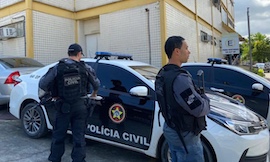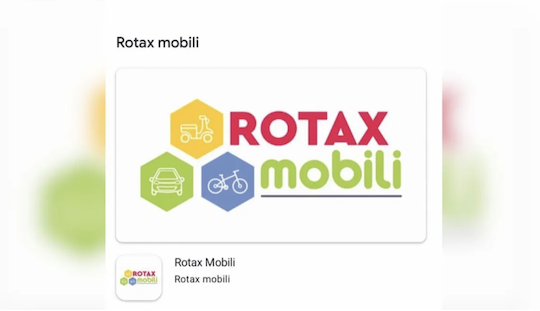The Comando Vermelho’s Mobile App: Criminal Innovation, Illicit Economies, and Armed Governance in Rio de Janeiro

The Red Command or Commando Vermelho (CV) has developed a mobile ride-sharing application (app) to further its operations and territorial control.[1] The revelation of a transportation app created by the CV marks a turning point in the reconfiguration of illicit economies in Rio de Janeiro. More than a curiosity, it is an indication of how illegal armed groups are incorporating digital technologies to expand their capacity for territorial control and revenue diversification. This phenomenon is part of a broader global dynamic in which organized crime expands its repertoire by articulating illicit and semi-legal markets, forms of coercion, and strategies of local governance.
The App as Criminal Innovation

Screen shot of the CV’s Rotax Mobli App. Source: Polícia Civil RJ.
The transportation app, known as “Rotax Mobli,” developed by the Comando Vermelho must be understood as an expression of the adaptive and innovative capacity of illicit economies. Marketed with the slogan “the only app that gets through the barricade and drops you off at your door,”[2] the service combined business logic with armed control, appropriating technology to structure markets under criminal domination. Beyond offering mobility in areas of restricted access, the platform reinforced territorial barriers, consolidated monopolies, and legitimized the illegal armed group’s presence within the community. Under the guise of a legitimate service, it functioned as a governance device, amplifying the asymmetry between crime and the state in the provision of urban goods.
Barricades play a central role in this context. Erected in streets and access points of favelas controlled by armed groups, they are composed of debris, concrete blocks, burned-out cars, metal fences, or other improvised structures. Their immediate purpose is to restrict the movement of people and vehicles, hinder the entry of police forces, and simultaneously regulate the circulation of residents, merchants, and service providers.
On the level of criminal governance, however, barricades transcend materiality: they constitute both symbolic and practical instruments of power. They demarcate boundaries of domination, reinforce the territoriality of the criminal armed groups, and institute a logic of enclosure that directly affects urban mobility and daily life.[3] Moreover, they obstruct state presence and formal business activity, imposing on local populations a growing dependence on structures administered by the armed group. Thus, more than physical obstacles, barricades should be understood as instruments of criminal sovereignty, transforming circulation within these territories into a strategic resource that shapes security dynamics, sociability, and survival.
Diversification of Illicit Economies
The adoption of mobile apps as operational tools highlights the CV’s adaptive capacity to digital transformations. The use of platforms simulating legitimate services allows the illegal or criminal armed group (CAG) to consolidate illicit monopolies in strategic sectors of the urban economy, especially in areas where the state’s presence is weak or unable to provide safe alternatives.
This trend aligns with a broader international scenario: Interpol has emphasized that the Covid-19 pandemic, combined with accelerated technological change, expanded opportunities for financial fraud and cybercrime—even as drug trafficking remains central, accounting for approximately 40–70% of global organized crime revenues.[4]
In Rio de Janeiro, this economic matrix has undergone significant transformations. According to the State Secretariat of Public Security, only 11% of the CV’s profits currently come from drug sales, while the majority derives from extortion of merchants and the appropriation of services considered essential—such as internet provision, gas distribution, alternative transportation, water sales, and even ice commerce.[5] These mechanisms function as a “criminal tax,” coercively imposed on local populations, eliminating competition, deepening community dependence, and reinforcing the IAG’s governance.
The app’s role must be interpreted within the broader process of digitalization of everyday life in Brazil. Recent data indicate that 85% of the adult population owns a smartphone, reaching 97% among individuals earning more than ten minimum wages. Moreover, 81% use banking apps, 61% conduct financial transactions via mobile phones, and 55% shop online.[6] This environment creates fertile ground for criminal appropriation of digital spaces, enabling criminal organizations to integrate traditional practices with new modalities sustained by the digital economy.
Money Laundering and Financial Networks
The CV’s digital innovation is linked to broader financial practices. In 2025, an investigation by the Rio de Janeiro Civil Police uncovered the largest money laundering scheme in the state’s history, moving approximately R$6 billion in a single year and involving both the CV and the First Capital Command or Primeiro Comando da Capital (PCC).[7] The mechanism operated through digital banks, financial technology firms (fintechs), and shell companies, demonstrating the articulation between local criminal circuits and global financial flows. This reinforces the point that criminal economies are not limited to territorial practices of coercion but project themselves into complex circuits of financialization.[8]
Convergence Between Gangs and Militias
The CV’s use of the app brings its practices closer to those of militias, whose expansion in Rio’s metropolitan areas has been facilitated by political advantages, selective police operations, and the capture of urban markets such as transportation and housing. The overlap of strategies between traditional narco gangs and militias, once seen as distinct forms of criminality, points toward hybrid arrangements in which extortion, control of services, and real estate markets are increasingly intertwined.[9]
Strategic Implications
The strategic implications of the CV’s transportation app and money laundering scheme reveal profound transformations in the functioning of illicit economies. First, crime is increasingly technologized, incorporating digital platforms as operational tools, which expands the innovative capacity of armed groups and enables them to adapt their practices to the digitalized dynamics of urban life. Second, a form of armed governance is consolidated, in which the provision of urban services such as transportation, gas, and internet creates regulatory and dependency arrangements that compete for legitimacy with the state and intervene directly in the daily lives of communities. Finally, the financialization of illicit economies emerges, expressed in billion-dollar laundering schemes that show how groups like the CV and PCC operate beyond the local scale, projecting themselves into complex financial circuits and networks. This triad: technological innovation, armed governance, and financialization, reveals the sophistication and adaptive capacity of organized crime in contemporary Brazil.
Conclusion
The CV’s transportation app exemplifies a broader process of criminal reconfiguration in Rio de Janeiro. It combines technological innovation, territorial coercion, and sophisticated financial circuits, articulating local and global dimensions of illicit economies. The case highlights the need to understand crime not merely as deviation or an external threat to the state but as a phenomenon operating within the tensions inherent with urban criminality (illegalisms).
Addressing this scenario requires public policies that move beyond drug-focused repression, incorporating strategies for market regulation, financial flow control, and institutional strengthening. Without such measures, organized crime will continue to reinvent itself and increasingly compete with the state for core governance functions.
Endnotes
[1] “Police dismantle Comando Vermelho’s mototaxi app generating R$1 million monthly profit.” Mix Vale. 8 August 2025, https://www.mixvale.com.br/2025/08/08/police-dismantle-comando-vermelhos-mototaxi-app-generating-r1-million-monthly-profit/.
[2] In the original Portuguese, “O único aplicativo de viagens de carro e moto que passa pela barricada e te deixa na porta de casa.” Reported at Camile Couto, “Veja como era aplicativo de transporte criado pelo Comando Vermelho.” CNN Brasil. 9 August 2025, https://www.cnnbrasil.com.br/nacional/sudeste/rj/veja-como-era-aplicativo-de-transporte-criado-pelo-comando-vermelho/.
[3] Júlia P.P. Quirino, Panóptico Criminal: A governança do Comando Vermelho no Rio de Janeiro(Dissertação de mestrado). Universidade Federal Fluminense (UFF). 2024.
[4] Interpol 2022 Annual Report: Global Crime Trends Report. Lyon: Interpol. 2022.
[5] Henrique Coelho and Felipe Freire, “Esquema que lavou R$ 6 bilhões do tráfico é a maior investigação da história, diz secretário.” Globo (G1). 10 April 2025, https://g1.globo.com/rj/rio-de-janeiro/noticia/2025/04/10/esquema-que-lavou-r-6-bilhoes-do-trafico-e-a-maior-investigacao-da-historia-diz-secretario.ghtml.
[6] Arthur Trindade M. Costa, “Os crimes cibernéticos e as novas dinâmicas criminais. Revista Fonte Segura–Fórum Brasileiro de Segurança Pública.” Revista Fonte Segura–Fórum Brasileiro de Segurança Pública. No. 245,. 4 September 2024, https://fontesegura.forumseguranca.org.br/os-crimes-ciberneticos-e-as-novas-dinamicas-criminais/.
[7] Op. cit., Coelho and Freire at Note 5.
[8] Lenia Pires, Daniel Veloso Hirata, and Salvador Aranda Maldonado, “Apresentação: Mercados Populares, Ilegalismos e suas Regulações pela Violência.” Antropolítica. No. 50. 2020, https://doi.org/10.22409/antropolitica2020.i50.a47749; Michel Misse, “Mercados ilegais, redes de proteção e organização local do crime.” Dossiê Crime Organizado. Vol. 21, no. 61. December 2007, https://doi.org/10.1590/S0103-40142007000300010.
[9] Daniel Veloso Hirata, Adauto Cardoso, Carolina Christoph Grillo, Orlando Alves dos Santos Junior, Diogo Azevedo Lyra, Renato Coelho Dirk, “The Expansion of Milícias in Rio de Janeiro. Political and Economic Advantages.” Journal of Illicit Economies and Development. Vol.4, no. 3: pp. 257–271, https://jied.lse.ac.uk/articles/10.31389/jied.140.







